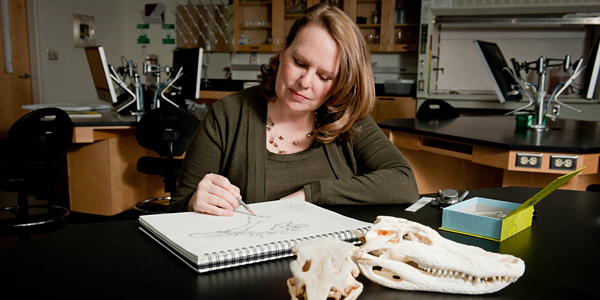Illustration Course Brings Art to Science

Jennifer Landin was 9 years old, cheerfully growing up in rural Michigan, when she had a life-changing epiphany. The colored-pencil sketch she’d created of a horse was pretty, but proportionally too long. When she halved the horse’s torso by folding the paper, however, the drawing became perfect.
“That’s when I first realized proportions are important and must be measured,” says Landin, now teaching assistant professor in the Department of Biology. “You need correct proportions for a drawing to work.”
This is the premise of Landin’s popular biological illustration course which teaches students to accurately draw life forms and to use illustration to learn how objects function and evolve.
Landin developed the course, now in its second year, while earning her doctorate at NC State. Her research explored the use of drawing as a teaching tool and how accurately science majors see proportion and detail.
“Anyone can do this. An engineer, mathematician or designer can feasibly draw equally as well,” she says.

Students from engineering, dentistry, design and biology attend the course—and while most have never drawn before, their illustrations are beautiful. This spring two regional galleries, the North Carolina Aquarium at Roanoke Island and the North Carolina Museum of Natural Sciences, will exhibit some of the work.
“The word is spreading,” Landin says.
What the Students Learn
The class starts with lab work, giving students a chance to closely observe the structures and anatomy of plants, animals, skeletons, even fungi. Then, Landin teaches the art techniques required to accurately draw the specimens. While people can draw objects without understanding the structure, she believes mistakes are inevitable.
For example, one student was drawing a stem with maple-like leaves. By learning in class that maple leaves grow on opposite sides of the stem, she determined her specimen was actually a sweet gum.
“Drawing a sweet gum as a maple would have looked silly. They are quite different,” Landin says.
In another class, Landin taught her students how pine needles are bundled by a structure called a fascicle. Later, when a student was drawing a comparison between pines, he almost omitted the fascicle in one group because it was so small. Yet when he looked in the microscope, there it was.
Landin says seeing that biological understanding in her students unfold is phenomenal. And while her students all seem surprised by the expert art they create, Landin isn’t surprised at all.
“I don’t really teach students to draw,” she says. “I teach them to see.”
- Categories:


